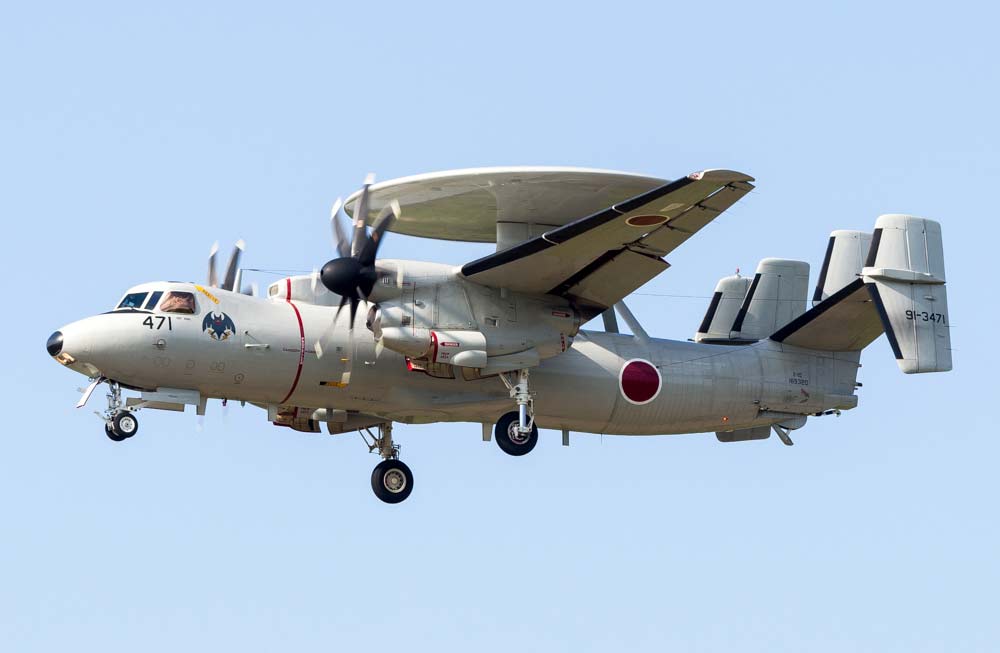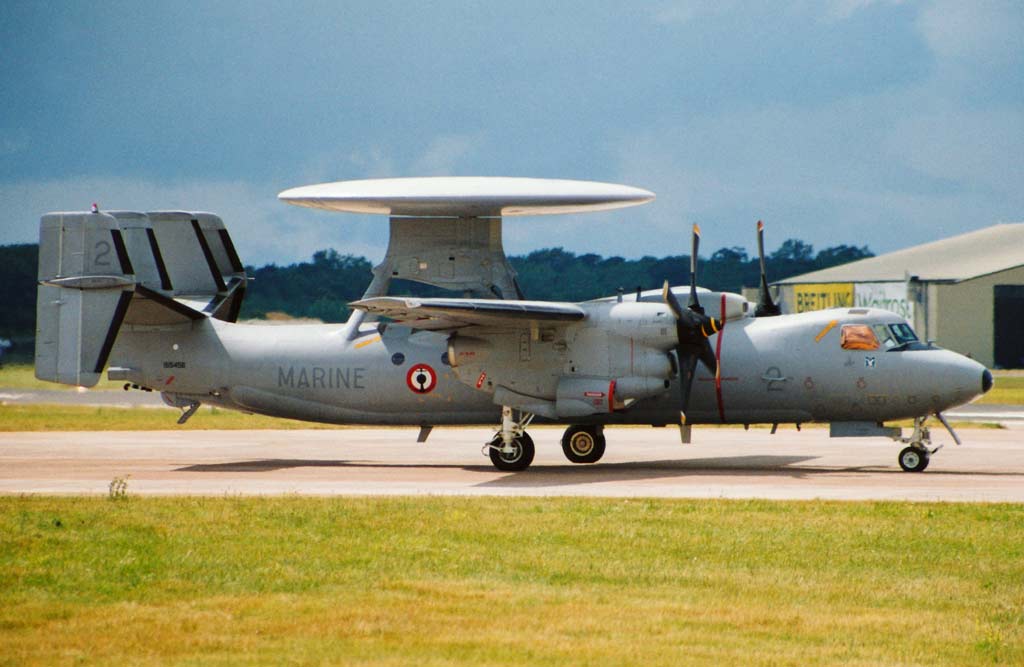The Northrop Grumman E-2 Hawkeye is an all-weather, carrier-capable tactical airborne early warning (AEW) aircraft.
In Brief
The E-2 Hawkeye is a twin-turboprop, high-wing aircraft equipped with a distinctive 24-foot rotating radar dome, providing 360-degree surveillance. Primarily used by the U.S. Navy, it serves as an airborne early warning and command and control platform, coordinating multi-domain operations. The Hawkeye features advanced avionics, electronic countermeasures, and a capability to operate from aircraft carriers, enhancing fleet defense and strategic air and missile defense. It’s crucial for battle management, theater air, and missile defense, and early warning of enemy actions during various missions.

The Northrop Grumman E-2 Hawkeye stands as a pivotal component in naval aviation, offering unparalleled airborne early warning and command and control capabilities. Its inception marked a significant advancement in tactical airborne surveillance, command, control, and communications.
History of the Development of the Northrop Grumman E-2 Hawkeye
The E-2 Hawkeye’s development began in the 1950s when the U.S. Navy identified a need for a new, all-weather airborne early warning (AEW) aircraft that could extend the radar coverage, hence enhancing the fleet’s air defense. Grumman (now Northrop Grumman) was awarded the contract, leading to the E-2’s first flight on October 21, 1960. The aircraft was designed to fill the gap for an AEW platform that could operate from an aircraft carrier, providing real-time tactical surveillance and command and control to air and sea assets.
During this era, the emergence of long-range missile technology and high-speed jet aircraft posed significant threats to naval forces, necessitating advanced early warning capabilities. The E-2 Hawkeye was developed to detect, track, and report hostile targets well before they could pose a threat, ensuring carrier battle groups could respond effectively to airborne, maritime, and land-based threats.
The introduction of the E-2 Hawkeye into service in the early 1960s provided the U.S. Navy with a significant enhancement in maritime surveillance, airborne command and control, and early warning capabilities. Its ability to coordinate combat operations while airborne, especially in the absence of land-based radar systems, revolutionized naval warfare strategies and force deployment.
The Hawkeye’s design and capabilities have evolved through its service life to adapt to new challenges and technological advancements, maintaining its status as a critical asset in carrier strike group defense and airborne command and control.
Design of the Northrop Grumman E-2 Hawkeye
The E-2 Hawkeye is engineered with a high-wing configuration, which houses two powerful Allison T56-A-425 turboprop engines, ensuring reliable performance and long endurance capabilities. The distinctive feature of the Hawkeye is its 24-foot-diameter rotating radar dome or rotodome, mounted above its fuselage, which houses the long-range radar and IFF systems. This design enables continuous 360-degree scanning, providing all-weather, day-night surveillance and precise tracking information over vast areas.
The aircraft’s airframe is optimized for carrier operations, featuring robust landing gear, a tailhook for arrested landings, and folding wings to save space on carriers. The cockpit is designed for a crew of five, including two pilots and three mission systems operators, ensuring comprehensive situational awareness and effective command and control.
Advantages of the E-2 design include its outstanding surveillance range, ability to operate in all weather conditions, and versatility in various missions, including air-sea rescue, drug interdiction, and humanitarian assistance. However, the aircraft’s size and the rotodome’s aerodynamic drag present challenges, particularly in terms of increased fuel consumption and limitations on speed and agility.
The Hawkeye’s avionics and systems have continually been upgraded to incorporate advanced radar, data link technology, and modernized communication systems, which have significantly enhanced its operational effectiveness, situational awareness, and network-centric warfare capabilities.
Performance of the Northrop Grumman E-2 Hawkeye
Equipped with twin Allison T56-A-425 turboprop engines, the E-2 Hawkeye offers a blend of endurance, speed, and reliability. It can reach speeds up to 350 knots (650 km/h), with a ceiling above 34,000 feet (10,000 meters), and a mission endurance of over 5 hours, extendable with aerial refueling. The aircraft’s operational range is substantial, allowing it to cover vast expanses of ocean and land.
The Hawkeye’s performance is centered around its powerful radar system, capable of tracking air and surface targets simultaneously, thereby providing a comprehensive picture of the operational environment. This capability ensures early warning of incoming threats and real-time command and control, which is vital for mission success in complex combat scenarios.
Comparatively, the E-2 stands out against other AEW platforms due to its ability to operate from aircraft carriers, providing unmatched flexibility and responsiveness. Its versatility and adaptability have been proven in various operational contexts, outperforming competitors by integrating advanced technology that supports a wide array of missions.
Variants of the Northrop Grumman E-2 Hawkeye
The E-2 Hawkeye has been produced in several variants, each with specific enhancements to meet evolving operational requirements:
- E-2B: An early variant with upgraded radar and computer systems.
- E-2C: Introduced in the 1970s, it featured significant avionics improvements, including more advanced radar and an enhanced computer system, which have been updated through several Group configurations.
- E-2D Advanced Hawkeye: The latest variant, boasting state-of-the-art radar systems, fully integrated all-glass tactical cockpit, and improved communications and data link capabilities.
Each variant represents an evolution in technology and capability, ensuring the Hawkeye remains an essential asset in modern naval operations.

Military Use and Combat of the Northrop Grumman E-2 Hawkeye
The E-2 Hawkeye has been a cornerstone of U.S. Navy operations since its introduction, playing pivotal roles in surveillance, air defense, and networked communications. It has been deployed in various conflicts, providing early warning of incoming threats and coordinating defense responses.
While the E-2 is not armed, its value lies in its ability to command and control the battlespace, significantly enhancing the situational awareness and combat effectiveness of military forces. Its real-time data and communications capabilities allow for coordinated responses, early threat detection, and seamless command and control functions, crucial in both conventional and asymmetrical warfare scenarios.
The Hawkeye has seen service in numerous military operations worldwide, from the Vietnam War to modern-day conflicts, proving its worth in enhancing air and missile defense, maritime security, and ground support. It has been exported to several countries, cementing its role as a vital component of modern military aviation.
The E-2 continues to be an active and essential element of the U.S. Navy, with the E-2D Advanced Hawkeye ensuring ongoing relevance in future operational scenarios, integrating with next-generation combat systems and aircraft carriers.
The Northrop Grumman E-2 Hawkeye is a testament to enduring design and adaptability, maintaining its status as a premier airborne early warning and control platform. Through continuous upgrades and iterations, it has stayed relevant to modern warfare’s demands, providing unparalleled situational awareness, airborne command and control, and operational flexibility. Its legacy is defined by its pivotal role in enhancing naval capability, ensuring maritime security, and supporting air, surface, and land forces in various operational theaters.
Back to the Special Aircraft section